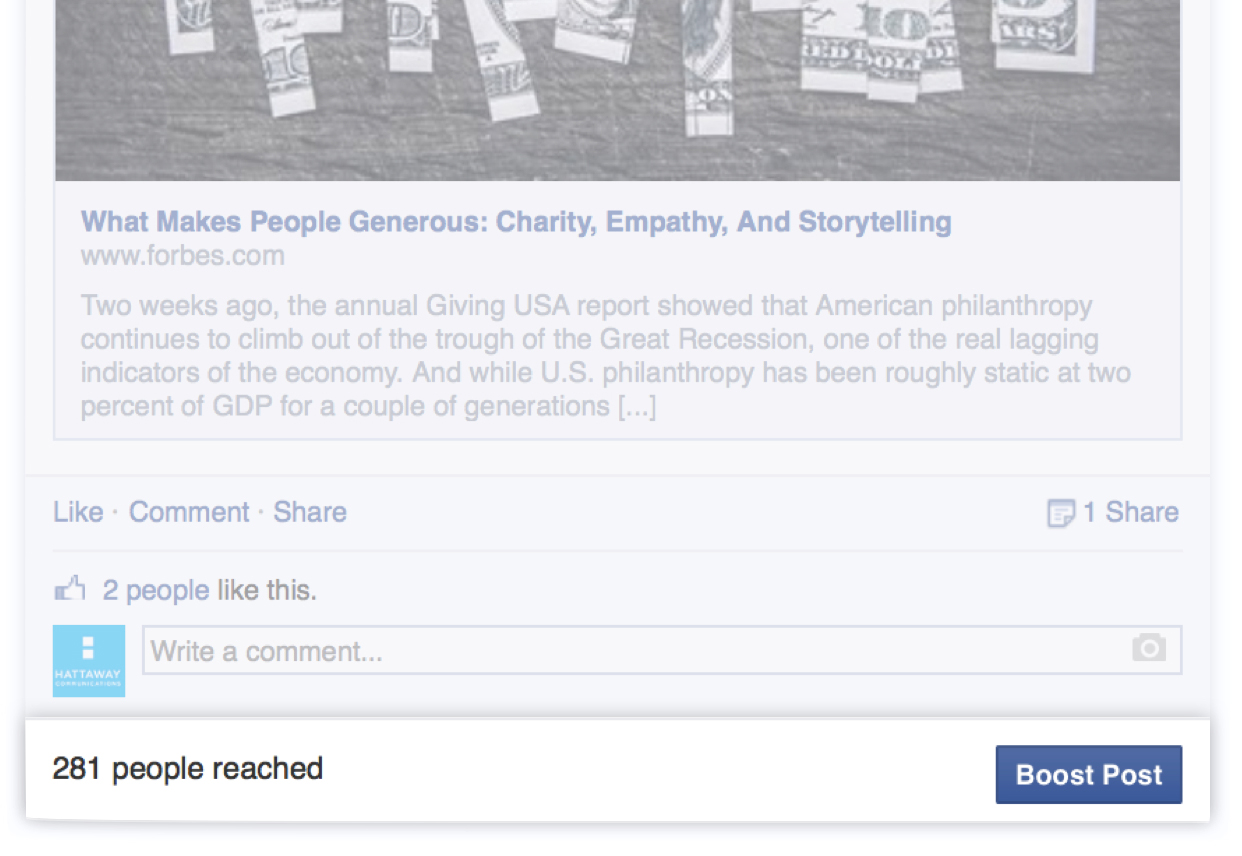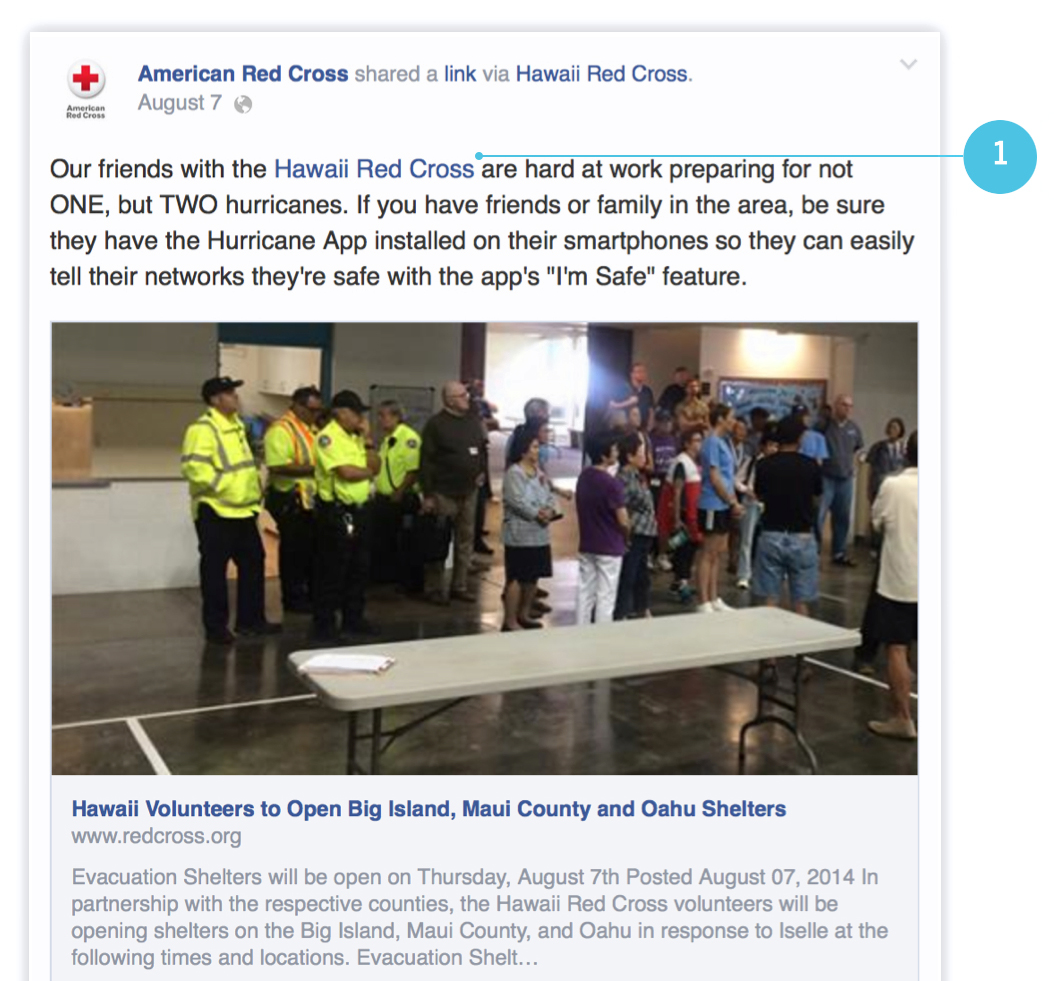A Guide to Facebook
What does Facebook do?
Facebook is the largest social networking site, with over one billion users, making it a popular tool to use when trying to reach and connect with a vast number of people in real time. Facebook allows you to share status updates, photos, videos, text, events, links and other multimedia content with your Friends and Followers.
Organizations can create a Page to share content and stories. Facebook also houses Pages dedicated to various causes, which may appear in your News Feed if you Like them.

- Like: Users can like your Page. Your Page’s activities and stories will then appear on their News Feeds.
- Message: Users can send a message that does not appear in public for anyone except the recipient to read.
Who does Facebook reach?
1.23 billion active users per month. 945 million mobile users. 757 million users per day.
- Largest social network. Facebook is the most widely used social network with over a billion users globally. In the United States, 71 percent of all Internet users have a Facebook account.
- Mobile. Facebook is on three of every four smartphones.
- Popularity. Facebook is the second most visited website in the world.
- Older generations. In the U.S., nearly two-thirds of 50–64 year olds and 43 percent of those aged 65+ are now on Facebook.
- International reach. The majority of Facebook’s users are outside the U.S.
- Gender. Women use Facebook more than their male counterparts—76 percent of online U.S. adult females use Facebook, compared to 66 percent for online males.
- Asia-Pacific. A large portion of Facebook’s user base is concentrated in the Asia-Pacific.
What do I need to use Facebook?
- Technology: Computer/phone/tablet, Internet connection
- Suggested Frequency: Once a day
What can I share on Facebook?
You can share status updates, photos, videos, text, events, links and other multimedia content on Facebook. You can also share events live with your followers with the Facebook Live feature.
How do I use Facebook?
Facebook has an online guide to help you get started. Instructions on creating a Page for an organization are available here.
Why should I use Facebook?
If you are aiming to engage specific audiences at scale and have the ability to produce content in a variety of formats, consider using Facebook. Facebook users tend to be more engaged than users of other platforms, so it is a top referral source. Users who engage with your organization on Facebook may be more likely to click your links than on any other platforms, based on your call to action.
- Comment: When users comment on your stories, not only does it spark conversations, but it may also appear in News Feed.
- Hashtag: Hashtags are often used for emphasis and less as a navigation tool on Facebook.
- Like: User can Like your Page. When they Like your Page, your content updates may appear in their own or their Friends’ News Feeds.
- React: If users Like or React to your stories or posts, their activity of engaging with your post may show up in their Friends’ News Feed.
- Share: When users click Share on Facebook, that story will appear on their Timeline and may appear in their Friends’ News Feed.
What are the strengths and limitations of Facebook?
Pros
- Largest social network. With over a billion users, Facebook is the most widely used social network globally. In the U.S., 71% of all Internet users have a Facebook account.
- Older generations. In the U.S., nearly two-thirds of 50–64 year olds and 43 percent of those aged 65+ are now on Facebook.
- Global Reach. The majority of Facebook’s users are outside the U.S.
- Multiple formats. Facebook is the right platform to showcase a variety of content types, such as text, video, photos and links.
- Chronological. The Timeline makes it easy to capture chronological events and allows audiences to follow major characters or themes within stories.
- Connected. Linking to blogs or other curated Pages adds an additional dimension to stories and drives traffic to other social or traditional media platforms.
- Action-oriented. Ability to include links in your posts provides opportunities to include direct and convenient actions for your audience, e.g., to donation pages.
- Ability to schedule. Facebook’s interface has the ability to schedule posts—a feature other social networks lack without the use of third-party applications.
- Paid content. Give your strongest stories placement on your audience’s News Feed through Facebook’s “Boosted Posts” feature.
- Causes. A Facebook application that enables users to organize themselves into communities of action that support specific issues, campaigns, or non-profit organizations.

Your content can be promoted with Facebook’s “Boosted Posts”, which is a paid feature. You can also use Facebook Ads to connect with targeted audiences.“
Cons
- Unpredictable. Users Comments can be unpredictable and inappropriate. Establishing social media guidelines and rules for Comment deletion/curation can help develop a baseline to monitor responses.
- Monitoring requirements. Comments and posts should be monitored daily and responses to Comments must be both thoughtful and genuine. This requires time investment and may require additional resources allocated to this social platform.
- Younger generation. Teenagers and ages 18 to 34 are increasingly less active on Facebook and opting to be more engaged on newer social networks such as Instagram. Although the trend reflects younger users are abandoning Facebook, it still has the highest number of registered users for these age groups.
- Balance. People on Facebook are hyper-aware of the content being posted which appears on their personal News Feeds. Sharing too much or too little can drive away your audience.
- Sponsored content. Preference is given to paid content on Facebook. Unless your posts are sponsored, they may run the risk of not reaching your audience effectively.
What story formats work best on Facebook?
Posts including images and videos prompt maximum interaction and engagement.
What’s the most effective way to share stories on Facebook?
Plan ahead, schedule and build editorial calendars with applications like Hootsuite, Buffer and others. When choosing a third party application, consider ease of use, your preference on layout and if it has the ability to publish on multiple platforms.
Third party applications provide convenience to schedule posts to multiple platforms. Facebook also provides the capability to schedule posts ahead of time, which is the most effective scheduling method.
How do Facebook users interact and share content?
- Like: Users can Like your Page. When they Like your Page, your content updates may appear in their own or their Friends’ News Feeds.
- React: If users Like or React to your stories or Posts, their activity of engaging with your post may show up in their Friends’ News Feeds.
- Share: When users click share on Facebook, that story will appear on their Timeline and may appear in their Friends’ News Feed.
- Comment: When users comment on your stories, not only does it spark conversations, but it may also appear in their News Feed.
- Stories: A relatively new feature on Facebook, users can upload a short video or photo that will expire within 24 hours on their "Story.”

- Tag: Individual users can tag Pages and individual profiles. However, you as an organization or Page can only tag other Pages.
- Hashtag: Hashtags are often used for emphasis and less as a navigation tool on Facebook.
- Message: Users can interact directly and privately by sending another user a message. Messages are not public and only visible to the recipient
How should I engage with users on Facebook?
- Be visual. Use images in your posts to attract the reader’s eye and accompany the picture with compelling text to increase engagement.
- Be consistent. Share content regularly in a consistent voice.
- Listen. Understand the voice of your audience.
- Be responsive. Try to always respond to Comments on your Page.
- Call to action. Ask your audiences to take action. Simple calls to action can lead to more engagement.
- Time your posts. Use Facebook Insights to track when your audience is online and then post content during those times for maximum engagement.
- Discuss current events. Your fans are more likely to share your content if it is relevant, timely and entertaining.
How can I maximize the visibility of my content on Facebook?
- Post at optimal times. Pay attention to when your audience is online by using Facebook Analytics. Post your content at times they are most likely to be active on Facebook.
- Use images. Post images and videos when possible.
- Consider frequency. Ideally, try to post once a day. Post 2 to 3 times a week, at the very least.
- Advertise. Your content can be promoted with Facebook’s Boosted Posts, which is a paid feature. You can also use Facebook Ads to connect with targeted audiences.
EXTERNAL RESOURCES
Related, on Storytelling for Good
You’ve Got a Story. Now What?
- 2 Saved
Community Foundation Two-Person Content Team
- 1 Comment
- 6 Saved
For Authentic Storytelling, Spend the Reputational Capital
You Have the Content, Now Create an Engaged Community
- 1 Comment
Trickle Up Shares Personal Journey in Email Campaign
- 1 Saved
Setting Up a Storybank
- 11 Saved





1 Comment
Dear Friends,family and donors
I would like to connect with you to help me to raise $ 5,000 to be used for improve the health of mother and child and economic growth for poor young mothers from rural areas of Nzega Tanzania.